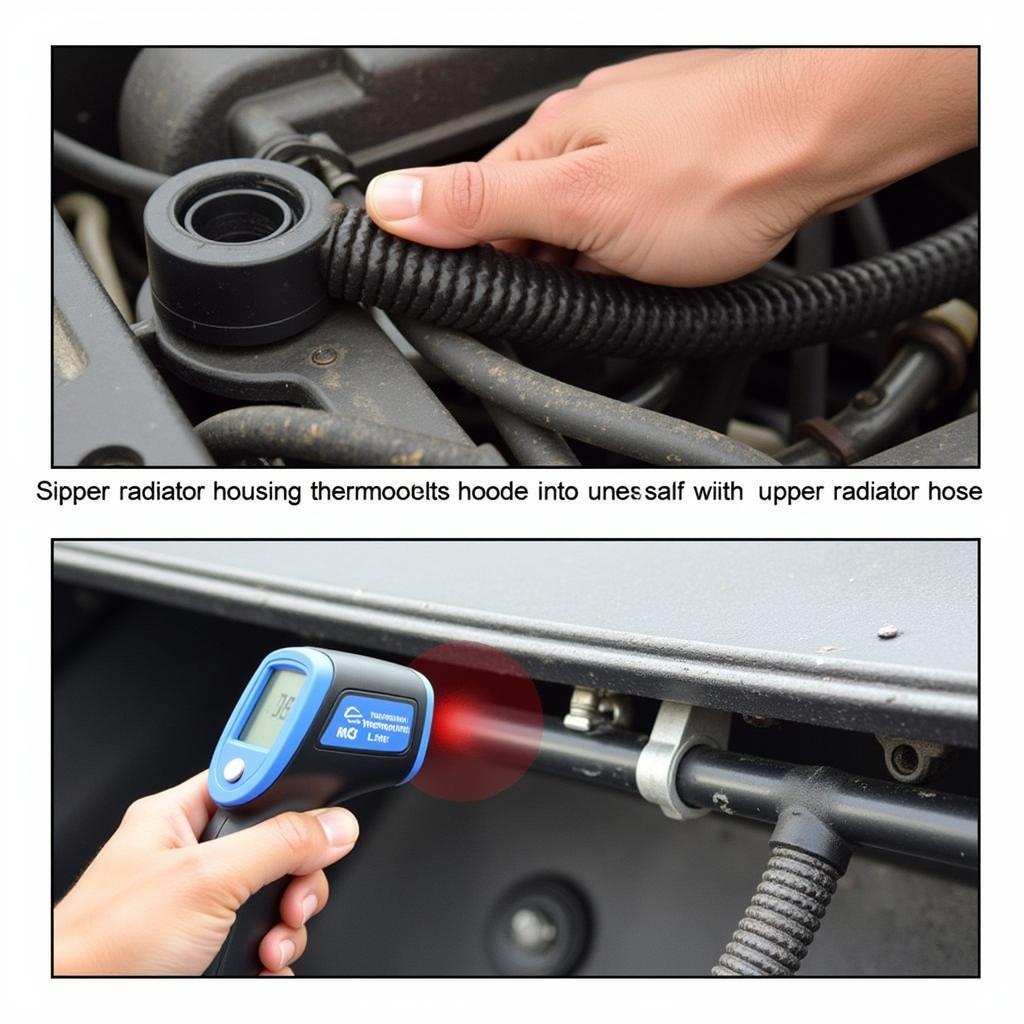A stuck open car thermostat can lead to poor fuel economy, slow engine warm-up, and reduced heater efficiency. This guide will show you how to diagnose and fix this common car problem, getting you back on the road with a properly functioning engine. Learn How To Fix A Car Thermostat Stuck Open and save yourself a trip to the mechanic. fix engine car
Signs of a Stuck Open Thermostat
Identifying a stuck open thermostat is the first step to fixing it. Here are some tell-tale signs:
- Engine takes too long to warm up: If your temperature gauge barely moves or takes an unusually long time to reach normal operating temperature, your thermostat could be stuck open.
- Poor fuel economy: A constantly cool engine burns more fuel.
- Lack of heat from the heater: A stuck open thermostat prevents the engine from reaching optimal temperature, resulting in insufficient heat from the car’s heater, especially noticeable in colder weather.
- Engine temperature fluctuating: While less common than a consistently low reading, fluctuating temperatures can also indicate a faulty thermostat.
Diagnosing a Stuck Open Thermostat
Before replacing the thermostat, it’s important to confirm the diagnosis. Here’s how:
- Check the upper radiator hose: With the engine cold, start the car. Carefully feel the upper radiator hose. If it warms up quickly after starting the engine, the coolant is flowing through the radiator prematurely, suggesting a stuck open thermostat.
- Use an infrared thermometer: Point the thermometer at the thermostat housing and the upper radiator hose. If the temperatures are similar shortly after starting the engine, this confirms the thermostat isn’t closing.
 Thermostat Diagnostic Test
Thermostat Diagnostic Test
How to Replace a Car Thermostat
Replacing a thermostat is a relatively straightforward procedure for most vehicles. fixing a car that ran out of oil Here’s a general guide:
- Gather your tools: You’ll need basic hand tools, a new thermostat, coolant, and a container to catch the old coolant.
- Locate the thermostat: The thermostat housing is usually located where the upper radiator hose connects to the engine.
- Drain the coolant: Locate the radiator drain cock and drain the old coolant into your container.
- Remove the thermostat housing: Disconnect the upper radiator hose and remove the bolts holding the thermostat housing in place.
- Replace the thermostat: Remove the old thermostat and install the new one, ensuring it’s oriented correctly. Most thermostats have a jiggle valve or an air bleed hole which should be positioned towards the top.
- Reassemble and refill: Reinstall the thermostat housing, reconnect the hose, and refill the cooling system with fresh coolant.
- Bleed the cooling system: Follow your vehicle’s specific instructions for bleeding the cooling system to remove any air pockets.
- Test the new thermostat: Start the engine and monitor the temperature gauge. It should reach normal operating temperature within a reasonable timeframe, and the upper radiator hose shouldn’t warm up immediately.
“A common mistake is failing to properly bleed the cooling system after replacing the thermostat. This can lead to overheating and further engine damage,” says John Smith, Senior Automotive Technician at Smith Automotive. help fix my car
Preventing Thermostat Issues
- Use the correct coolant: Using the wrong coolant can damage the thermostat and other cooling system components.
- Regularly flush the cooling system: Flushing the system helps remove contaminants that can contribute to thermostat failure.
Conclusion
Learning how to fix a car thermostat stuck open can save you time and money. By understanding the symptoms, performing a proper diagnosis, and following the replacement steps, you can keep your car running smoothly. Don’t hesitate to contact AutoTipPro at +1 (641) 206-8880 or visit our office at 500 N St Mary’s St, San Antonio, TX 78205, United States for further assistance. fixing a car engine for dummies
FAQ
-
How long does it take to replace a thermostat? Replacing a thermostat typically takes 1-2 hours.
-
Can I drive with a stuck open thermostat? Yes, but it’s not recommended for extended periods, as it can lead to reduced fuel economy and potential engine wear.
-
How much does a thermostat replacement cost? A thermostat itself is relatively inexpensive, but labor costs can vary.
-
What are the symptoms of a stuck closed thermostat? Overheating is the primary symptom of a stuck closed thermostat.
-
How often should I replace my thermostat? There’s no specific interval, but it’s a good idea to replace it when performing other cooling system maintenance, such as a coolant flush.
-
Can a bad thermostat cause engine damage? Yes, both a stuck open and a stuck closed thermostat can eventually lead to engine damage if not addressed.
-
What tools do I need to replace a thermostat? Basic hand tools, such as wrenches and screwdrivers, are typically required.




Leave a Reply